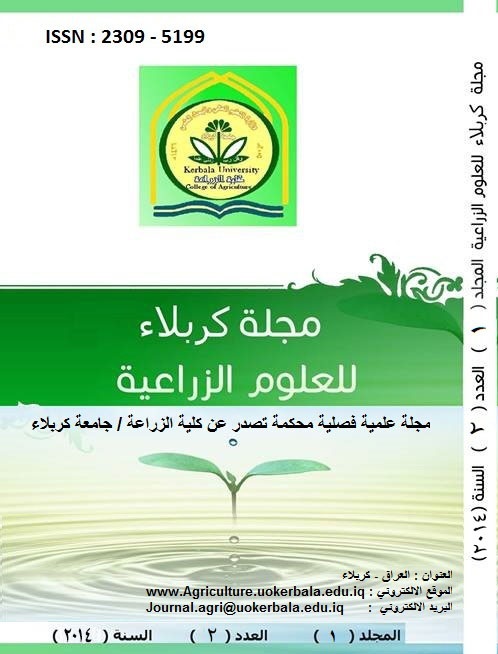Induction of some antioxidant enzymes of two bread wheat varieties (Triticum aestivum l.) and two durum wheat (Triticum durum l.) under zinc and bicarbonate stress.
DOI:
https://doi.org/10.59658/jkas.v1i2.354Abstract
To study effect of Zn,HCO3 Stress in wheat genotype , experiment were conducted in stats hydroponics technique, in greenhouse of Soil and water sciences department –Agriculture college/Baghdad university intention study effect of Zn and three levels of bicarbonate stress(0,2000,4000 µM.L-1) ,from KHCO3 silt . Four varieties were uses two from Bread Wheat (Iba99 and Sham6),and two from durum wheat(Sin AL-Jamal and Jndolh). Experiment setup using Complete Randomized Design (CRD). Results of this Study showed varieties exposure to Zn stress redound in development and emersion Zn deficiency. Zn deficiency differences between wheat varieties .varieties exposure to Zn,HCO3(2000 and 4000 µM.L-1)stress exacerbate Zn deficiency phenomenon .Accompany Zn deficiency emersion a significant decreased in shoots and roots fresh weight ,especially under Zn ,HCO3 stress assembly.Iba99 from bread wheat given highest values in shoots and roots fresh weight compared with Sham6 varieties .Simi behavior showed in architectures roots .Also Iba99 given highest values in total chlorophyll concentration compared with other varieties. Zinc concentration a significant decreased when varieties grown under Zn, HCO3 stress, with superior Iba99 in active Zinc concentration (84.15 and 73.20 mg.Kg-1)at highest HCO3 stress (4000 µM.L-1)under Zn deficient or efficient respectively. Jndolh from durum wheat was superior in all characterizes compared with Sin AL-Jamal. All varieties given high assemble of organic acid (Malic, Citric and Oxalic) in Roots. This is clear signaler on varieties were effected to Zn and HCO3 stress. Antioxidant enzymes activity (SOD,POD,CAT) were given clear signaler on effected of wheat varieties under Zn,HCO3 stress .This is deductive on scavenging to ROS eventual from Zn,HCO3 stress.Iba99 given highest values in SOD and CAT(324.4 and 516.5 u.mg p.-1),when growth under Zn deficient and highest HCO3 stress (4000 µM.L-1) respectively. Also Iba99 given highest values in POD enzyme active (65.37 u A.gm-1) under Zn deficient and highest HCO3 stress(4000 µM.L-1).Jndolh was superior in all antioxidant enzyme(SOD,POD and CAT)compared with Sin AL-Jamal . This study suggested capability to use antioxidant enzymes activity as important criterion to separation efficiencies varieties which tolerance Zn, HCO3 stress ,and give early signaler to varieties separation to stress tolerance.
Downloads
Published
How to Cite
Issue
Section
License
Copyright (c) 2014 Copyright (c) 2024 is the Author's article. Published by the Journal of Kerbala for Agricultural Sciences under a CC BY 4.0 license

This work is licensed under a Creative Commons Attribution 4.0 International License.
Licensing Terms
All articles are published under a Creative Commons License and will be directed to the Creative Commons Attribution 4.0 International License (CC BY 4.0) That permits use, distribution, and reproduction in any medium, provided the original work is properly cited. This license also allows the work to be used for commercial purposes.
Use by both non-commercial and commercial users
This content is licensed under a Creative Commons Attribution 4.0 International (CC BY 4.0) license, permitting use by both non-commercial and commercial users. Individual users may access, download, copy, display, and redistribute the articles to colleagues, as well as adapt, translate, and text- and data-mine the content, subject to the following conditions:
- The author's moral rights, including the right of attribution and the right to protect their work from derogatory treatment, are respected.
- Where content in the article is identified as belonging to a third party, users must ensure that any reuse complies with the copyright policies of the owner of that content.
- If the article content is reused for research or educational purposes, users should maintain a link to the appropriate bibliographic citation, including the DOI and a link to the published version on the journal's website.

